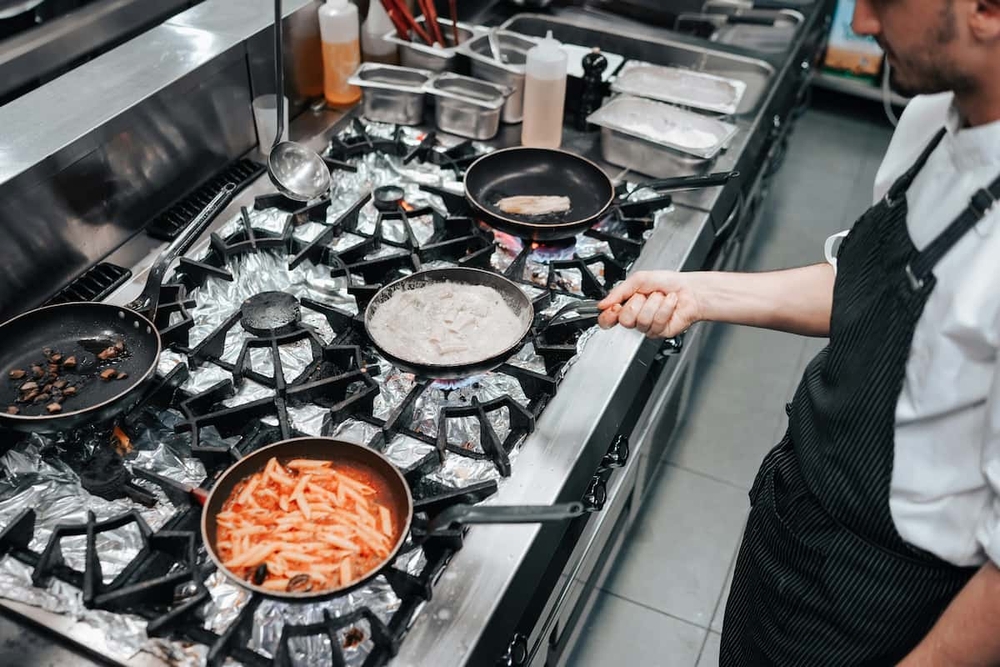Cybersecurity for restaurants: 7 common risks and how to avoid them
Table of Contents
CloudKitchens
How many tacos can be delivered from a 1000sqft restaurant?
The same amount as a 200sqft ghost kitchen.
In an increasingly digital world, cybersecurity for restaurants is more important than ever. From online reservations and digital payments to cloud-based POS systems and customer loyalty programs, restaurants handle a vast amount of sensitive data. Unfortunately, this makes them prime targets for cyberattacks.
Cybercriminals are constantly looking for vulnerabilities in restaurant systems to steal customer information, disrupt operations, and demand ransom. A single breach can lead to financial loss, legal consequences, and reputational damage. Understanding the risks and implementing strong cybersecurity measures is crucial to protecting your restaurant.
In this guide, we will explore common cybersecurity threats faced by restaurants and the best practices to keep your business and customers safe.
What is a cyberattack?
A cyberattack is any attempt by hackers or malicious actors to gain unauthorized access to a computer system, network, or database. These attacks can take various forms, including data breaches, phishing scams, malware infections, and ransomware.
Cybercriminals target restaurants because they handle a large volume of customer data, including credit card information, personal details, and login credentials.
What is a restaurant data breach?
A restaurant data breach occurs when unauthorized individuals gain access to sensitive business or customer information. This can happen through hacking, insider threats, or weak security measures. These data can be found in social media, websites and any data your business may have online.
A breach can expose customer payment details, employee records, and proprietary business data. The consequences can be severe, including legal penalties, loss of customer trust, and financial losses.
Read more: Integrating AI in your ghost kitchen operations: boost efficiency & profits
Common cybersecurity risks for restaurants
There are a few cybersecurity risks that everybody that has a business can pass through. But let’s see the main ones for you to be prepared for any kind of cybersecurity possible attacks. But don’t worry! The problems exist, but doesn’t mean you will for sure pass through it, but you must be prepared.
1. Point-of-sale (POS) system attacks
Your POS system is one of the most critical components of your restaurant’s operations. However, it is also one of the most vulnerable to cyberattacks. Hackers often target POS systems to steal credit card information, leading to financial fraud and identity theft. Malware, skimming devices, and network breaches are common ways cybercriminals exploit POS vulnerabilities.
Read more: Restaurant Technology: Boost your business with the best technology trends
2. Ransomware attacks
Ransomware is a type of malware that locks your restaurant’s systems or data until a ransom is paid. Cybercriminals can encrypt customer data, online orders, payroll information, and inventory details, bringing your operations to a standstill. Paying the ransom is not always a guarantee that you will regain access, making prevention crucial.
3. Phishing scams
Phishing attacks involve cybercriminals impersonating legitimate businesses or employees to trick restaurant staff into sharing sensitive information. These scams often come in the form of fake emails, text messages, or calls that request login credentials, financial details, or other private data.
4. Insider threats
Not all cyber threats come from external hackers. Disgruntled employees or negligent staff members can unintentionally or deliberately expose your restaurant to data breaches. Unauthorized access, improper handling of customer data, and sharing sensitive passwords can all lead to security risks.
5. Wi-Fi vulnerabilities
Offering free Wi-Fi is a great way to attract customers, but it also presents a security risk. If your public Wi-Fi is not properly secured, hackers can intercept data transmissions, access customer devices, and even infiltrate your restaurant’s internal systems.
6. Third-party vendor risks
Many restaurants rely on third-party services such as delivery platforms, reservation systems, and online ordering apps. If these vendors do not have robust security measures in place, your restaurant’s data could be at risk. A security breach at a third-party provider can compromise customer information and damage your reputation.
7. Weak password management
Using simple or repeated passwords across different systems makes it easy for hackers to gain access to sensitive information. Weak passwords and lack of multi-factor authentication (MFA) are common security lapses in the restaurant industry.
Read more: Smart strategies and tips to optimize delivery routes for your restaurant
How to protect your restaurant from cyber threats
1. Secure your POS system
- Use end-to-end encryption for all payment transactions.
- Keep your POS software and hardware updated with the latest security patches.
- Limit employee access to POS systems based on their roles.
2. Implement strong password policies
- Require complex passwords with a mix of uppercase, lowercase, numbers, and special characters.
- Use multi-factor authentication (MFA) for all accounts.
- Change passwords regularly and never reuse old ones.
3. Train your employees on cybersecurity
- Educate your restaurant staff on how to recognize phishing emails and suspicious links.
- Implement protocols for handling customer data safely.
- Restrict access to sensitive information based on job roles.
4. Use secure Wi-Fi networks
- Separate guest Wi-Fi from your internal business network.
- Use strong encryption methods (such as WPA3) for your Wi-Fi security.
- Regularly update router firmware to prevent vulnerabilities.
5. Backup data regularly
- Schedule automatic backups for your restaurant’s important data.
- Store backups offsite or in secure cloud storage to prevent loss from ransomware attacks.
- Test your backups to ensure they can be restored quickly.
6. Work with secure third-party vendors
- Ensure all vendors follow industry-standard security practices.
- Require vendors to use secure authentication methods when accessing your systems.
- Regularly review vendor security policies and compliance.
7. Monitor for suspicious activity
- Use firewalls and intrusion detection systems to block cyber threats.
- Set up alerts for unusual login attempts or data access.
- Regularly audit system logs for any suspicious behavior.
8. Invest in cybersecurity insurance
- Cyber insurance can help cover the financial impact of a data breach.
- Choose a policy that includes data recovery, legal fees, and business interruption coverage.
Read more: How restaurant analytics can transform your operations
Why does your business have to be protected from cyberattacks?
Cybersecurity is essential for restaurants because a single cyberattack can have devastating effects, including:
- Financial losses – Recovering from a breach or ransomware attack can be costly.
- Reputation damage – Customers may lose trust in your brand if their data is compromised.
- Legal penalties – Non-compliance with data protection laws can result in fines.
- Operational disruptions – A cyberattack can shut down your ordering and payment systems.
By investing in cybersecurity measures, you can protect your restaurant from these risks and ensure smooth operations.
How CloudKitchens helps protect your restaurant’s data
At CloudKitchens, we understand that restaurant cybersecurity is a growing concern. Our platform ensures that your data and operations remain secure, allowing you to focus on delivering exceptional food and service.
Don’t wait until a cyberattack disrupts your business. Secure your restaurant with the right cybersecurity measures. Learn more about how CloudKitchens can help safeguard your operations!
DISCLAIMER: This information is provided for general informational purposes only and the content does not constitute an endorsement. CloudKitchens does not warrant the accuracy or completeness of any information, text, images/graphics, links, or other content contained within the blog content. We recommend that you consult with financial, legal, and business professionals for advice specific to your situation.
More insights & stories
There’s more where that came from.
Get in the know and check out our additional insights


